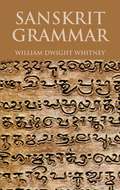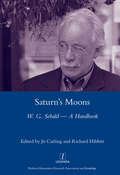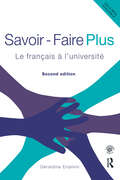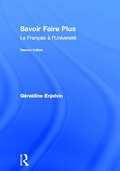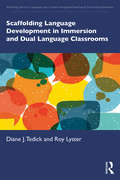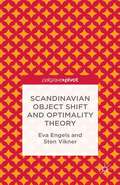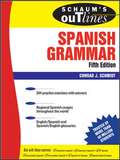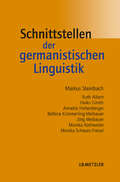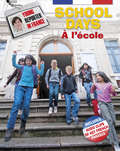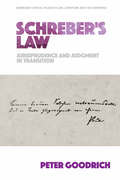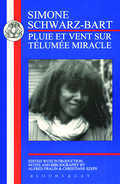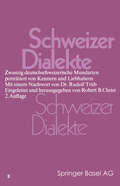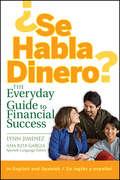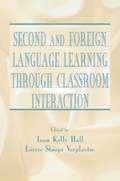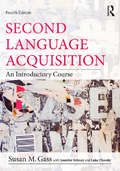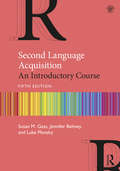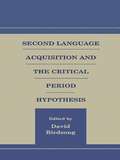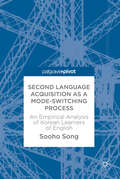- Table View
- List View
Sanskrit Grammar
by William Dwight WhitneyAs Latin is key to the study of Western classics, so Sanskrit is the gateway to understanding ancient Indian literature. One of the few Sanskrit grammars currently available, this meticulously researched and thoughtfully assembled guide to the language's basics will prove valuable to students of Indian culture and history.Focusing on the fundamentals of Sanskrit as revealed in literary classics, the text follows the forms and constructions of the older language, as exhibited in the Veda and the Brahamana. It begins with an introduction to the Sanskrit alphabet, followed by a treatment of the accent -- its changes in combination and inflection, and the tone of the individual worlds. Succeeding chapters discuss declension, conjugation, parts of speech, and formation of compound stems. A helpful appendix, Sanskrit index, and general index conclude the text.
Saturn's Moons: A W.G Sebald Handbook
by Jo CatlingThe German novelist, poet and critic W. G. Sebald (1944-2001) has in recent years attracted a phenomenal international following for his evocative prose works such as Die Ausgewanderten (The Emigrants), Die Ringe des Saturn (The Rings of Saturn) and Austerlitz, spellbinding elegiac narratives which, through their deliberate blurring of genre boundaries and provocative use of photography, explore questions of Heimat and exile, memory and loss, history and natural history, art and nature. Saturn's Moons: a W. G. Sebald Handbook brings together in one volume a wealth of new critical and visual material on Sebald's life and works, covering the many facets and phases of his literary and academic careers -- as teacher, as scholar and critic, as colleague and as collaborator on translation. Lavishly illustrated, the Handbook also contains a number of rediscovered short pieces by W. G. Sebald, hitherto unpublished interviews, a catalogue of his library, and selected poems and tributes, as well as extensive primary and secondary bibliographies, details of audiovisual material and interviews, and a chronology of life and works. Drawing on a range of original sources from Sebald's Nachlass - the most important part of which is now held in the Deutsches Literaturarchiv Marbach - Saturn's Moons6g will be an invaluable sourcebook for future Sebald studies in English and German alike, complementing and augmenting recent critical works on subjects such as history, memory, modernity, reader response and the visual. The contributors include Mark Anderson, Anthea Bell, Ulrich von Buelow, Jo Catling, Michael Hulse, Florian Radvan, Uwe Schuette, Clive Scott, Richard Sheppard, Gordon Turner, Stephen Watts and Luke Williams. Jo Catling teaches in the School of Literature at the University of East Anglia and Richard Hibbitt in the Department of French at the University of Leeds.
Saturn's Moons: A W.G Sebald Handbook
by Jo CatlingThe German novelist, poet and critic W. G. Sebald (1944-2001) has in recent years attracted a phenomenal international following for his evocative prose works such as Die Ausgewanderten (The Emigrants), Die Ringe des Saturn (The Rings of Saturn) and Austerlitz, spellbinding elegiac narratives which, through their deliberate blurring of genre boundaries and provocative use of photography, explore questions of Heimat and exile, memory and loss, history and natural history, art and nature. Saturn's Moons: a W. G. Sebald Handbook brings together in one volume a wealth of new critical and visual material on Sebald's life and works, covering the many facets and phases of his literary and academic careers -- as teacher, as scholar and critic, as colleague and as collaborator on translation. Lavishly illustrated, the Handbook also contains a number of rediscovered short pieces by W. G. Sebald, hitherto unpublished interviews, a catalogue of his library, and selected poems and tributes, as well as extensive primary and secondary bibliographies, details of audiovisual material and interviews, and a chronology of life and works. Drawing on a range of original sources from Sebald's Nachlass - the most important part of which is now held in the Deutsches Literaturarchiv Marbach - Saturn's Moons6g will be an invaluable sourcebook for future Sebald studies in English and German alike, complementing and augmenting recent critical works on subjects such as history, memory, modernity, reader response and the visual. The contributors include Mark Anderson, Anthea Bell, Ulrich von Buelow, Jo Catling, Michael Hulse, Florian Radvan, Uwe Schuette, Clive Scott, Richard Sheppard, Gordon Turner, Stephen Watts and Luke Williams. Jo Catling teaches in the School of Literature at the University of East Anglia and Richard Hibbitt in the Department of French at the University of Leeds.
Savoir Faire Plus: Le Français à l’Université
by Géraldine EnjelvinWritten by an experienced tutor, Savoir-Faire Plus is specifically designed to meet the requirements of today’s generation of language undergraduates. Focusing on the life of an Anglophone first year undergraduate studying French in the UK and sharing a house with four francophone students, this engaging textbook provides: a clear, logical structure a blend of communicative, research-based and traditional exercises a wide range of activities covering the four key linguistic skills as well as intercultural skills authentic texts (with extracts from Le Monde, L’Express, Le Nouvel Observateur and Libération) guidance and practical tips for effective and independent learning. Each of the ten chapters consists of four topics-based sections which provide students with a wealth of diverse material allowing them to gain an in-depth knowledge of relevant topical subjects such as regional languages, sustainable development and fair trade, amongst others. Digestible grammar points are integrated throughout and a range of additional exercises are available on the Companion Website allowing students to perfect their language skills. Suitable for both self-study and class use Savoir Faire Plus is the ideal course for all advanced students of French, consolidating knowledge gained at A-Level while supporting the transition to undergraduate study. The Companion Website can be found at www.routledge.com/textbooks/9780415444750
Savoir Faire Plus: Le Français à l’Université
by Géraldine EnjelvinWritten by an experienced tutor, Savoir-Faire Plus is specifically designed to meet the requirements of today’s generation of language undergraduates. Focusing on the life of an Anglophone first year undergraduate studying French in the UK and sharing a house with four francophone students, this engaging textbook provides: a clear, logical structure a blend of communicative, research-based and traditional exercises a wide range of activities covering the four key linguistic skills as well as intercultural skills authentic texts (with extracts from Le Monde, L’Express, Le Nouvel Observateur and Libération) guidance and practical tips for effective and independent learning. Each of the ten chapters consists of four topics-based sections which provide students with a wealth of diverse material allowing them to gain an in-depth knowledge of relevant topical subjects such as regional languages, sustainable development and fair trade, amongst others. Digestible grammar points are integrated throughout and a range of additional exercises are available on the Companion Website allowing students to perfect their language skills. Suitable for both self-study and class use Savoir Faire Plus is the ideal course for all advanced students of French, consolidating knowledge gained at A-Level while supporting the transition to undergraduate study. The Companion Website can be found at www.routledge.com/textbooks/9780415444750
Scaffolding Language Development in Immersion and Dual Language Classrooms (Routledge Series in Language and Content Integrated Teaching & Plurilingual Education)
by Roy Lyster Diane J. TedickThis book introduces research-based pedagogical practices for supporting and enhancing language development and use in school-based immersion and dual language programs in which a second, foreign, heritage, or indigenous language is used as the medium of subject-matter instruction. Using counterbalanced instruction as the volume’s pedagogical framework, the authors map out the specific pedagogical skill set and knowledge base that teachers in immersion and dual language classrooms need so their students can engage with content taught through an additional language while continuing to improve their proficiency in that language. To illustrate key concepts and effective practices, the authors draw on classroom-based research and include teacher-created examples of classroom application. The following topics are covered in detail: defining characteristics of immersion and dual language programs and features of well-implemented programs strategies to promote language and content integration in curricular planning as well as classroom instruction and performance assessment an instructional model to counterbalance form-focused and content-based instruction scaffolding strategies that support students’ comprehension and production while ensuring continued language development an approach to creating cross-linguistic connections through biliteracy instruction a self-assessment tool for teachers to reflect on their pedagogical growth Also applicable to content and language integrated learning and other forms of content-based language teaching, this comprehensive volume includes graphics to facilitate navigation and provides Resources for Readers and Application Activities at the end of each chapter. The book will be a key resource for preservice and in-service teachers, administrators, and teacher educators.
Scaffolding Language Development in Immersion and Dual Language Classrooms (Routledge Series in Language and Content Integrated Teaching & Plurilingual Education)
by Roy Lyster Diane J. TedickThis book introduces research-based pedagogical practices for supporting and enhancing language development and use in school-based immersion and dual language programs in which a second, foreign, heritage, or indigenous language is used as the medium of subject-matter instruction. Using counterbalanced instruction as the volume’s pedagogical framework, the authors map out the specific pedagogical skill set and knowledge base that teachers in immersion and dual language classrooms need so their students can engage with content taught through an additional language while continuing to improve their proficiency in that language. To illustrate key concepts and effective practices, the authors draw on classroom-based research and include teacher-created examples of classroom application. The following topics are covered in detail: defining characteristics of immersion and dual language programs and features of well-implemented programs strategies to promote language and content integration in curricular planning as well as classroom instruction and performance assessment an instructional model to counterbalance form-focused and content-based instruction scaffolding strategies that support students’ comprehension and production while ensuring continued language development an approach to creating cross-linguistic connections through biliteracy instruction a self-assessment tool for teachers to reflect on their pedagogical growth Also applicable to content and language integrated learning and other forms of content-based language teaching, this comprehensive volume includes graphics to facilitate navigation and provides Resources for Readers and Application Activities at the end of each chapter. The book will be a key resource for preservice and in-service teachers, administrators, and teacher educators.
Scandinavian Object Shift and Optimality Theory
by E. Engels S. ViknerThis book presents an account of object shift, a word order phenomenon found in most of the Scandinavian languages where an object occurs unexpectedly to the left and not to the right of a sentential adverbial. With new and original observations, it is an important addition to the fields of phonology, optimality theory and theoretical syntax.
Schaum's Outline Of Spanish Grammar (PDF)
by Conrad J. SchmittSchaum's Outline of Spanish Grammar makes Spanish grammar simple with exercises, quick drills, and helpful verb charts. The fifth edition includes extensive coverage of Spanish usage in Latin American countries.
Schnittstellen der germanistischen Linguistik
by Markus SteinbachDie ideale Ergänzung zum Lehrbuch Einführung in die germanistische Linguistik . Der Band konzentriert sich auf die für Universität und Praxis wichtigsten Anwendungsbereiche der Sprachwissenschaft. Dazu zählen: Methoden des empirischen Arbeitens, Psycholinguistik, Zweitspracherwerb, Gebärdensprache, Variationslinguistik, Text- und Gesprächsanalyse sowie Linguistik und Literatur. Dank vieler Übungsaufgaben auch zur Vorbereitung von Seminaren und Prüfungen bestens geeignet.
School Days (Young Reporter in France #3)
by Sue Finnie Daniele BourdaisMeet Ryan. He is in France on a special mission. He is going to find out what it is like to go to school in France. Follow Ryan's blog to find out what French pupils wear at school, what they do at lunch times, what after school lunch clubs there are and much more. You can also learn some key French phrases, pick up French language tips and test your knowledge of France with the mini quizzes. Go to franklinwatts.co.uk for your free downloads of the French conversations in this book.School Days is part of the Young Reporter in France series. They are a great resource for the KS2 and 3 Framework for Languages which include an Intercultural Understanding strand where children compare and contrast life in other countries with their own.
Schreber’s Law: Jurisprudence and Judgment in Transition (Edinburgh Critical Studies In Law, Literature And The Humanities Ser.)
by Peter GoodrichHow did Russian writers respond to linguistic debate in the post-Soviet period?
Schreber’s Law: Jurisprudence and Judgment in Transition
by Peter GoodrichThe first scholarly comparative analysis of Jacques Derrida and Gilles Deleuze's philosophies of difference
Schwarz-Bart: Pluie et Vent sur Télumée Miracle
by Simone Schwarz-Bart Alfred Fralin Christiane SzepsGreat-granddaughter of Minerve, first woman of the Guadeloupean branch of the Lougandor family to be freed from slavery in 1848, the elderly Telumée tells the story of her own difficult life and that of her ancestors. It is a poor black woman's tale of heroic survival, set in the early 20th century, harsh agrarian environment of a Caribbean island.Through the richly imaged narration of a constantly evolving, cultural significant and always entertaining saga, the author leads the reaer into her native West Indian realm of legends, magic, folkloric wisdom and traditional reverence for the elderly and the past. Her protagonist, Telumée, embodies the innate strength and nobility of women in general and of black Caribbean women in particular.Published in 1972, this book received Elle magazine's literary prize. This edition reflects the editor's personal acquaintance with the author, and her country. It provides a synthesis of the latest critical studies, and a thorough interpretation of Creole terms, symbolic imagery and a unique cultural background.
Schwarz-Bart: Pluie et Vent sur Télumée Miracle
by Simone Schwarz-Bart Alfred Fralin Christiane SzepsGreat-granddaughter of Minerve, first woman of the Guadeloupean branch of the Lougandor family to be freed from slavery in 1848, the elderly Telumée tells the story of her own difficult life and that of her ancestors. It is a poor black woman's tale of heroic survival, set in the early 20th century, harsh agrarian environment of a Caribbean island.Through the richly imaged narration of a constantly evolving, cultural significant and always entertaining saga, the author leads the reaer into her native West Indian realm of legends, magic, folkloric wisdom and traditional reverence for the elderly and the past. Her protagonist, Telumée, embodies the innate strength and nobility of women in general and of black Caribbean women in particular.Published in 1972, this book received Elle magazine's literary prize. This edition reflects the editor's personal acquaintance with the author, and her country. It provides a synthesis of the latest critical studies, and a thorough interpretation of Creole terms, symbolic imagery and a unique cultural background.
¿Se Habla Dinero?: The Everyday Guide to Financial Success
by Lynn JimenezA bilingual guide to the basics of financial success. Getting ahead financially in the United States is a difficult task, and it is even more daunting for someone who comes from a different culture. That’s why author Lynn Jimenez has created ¿Se Habla Dinero?: The Everyday Guide to Financial Success. This book offers information needed for financial survival and success, simply and clearly, in both English and Spanish. ¿Se Habla Dinero? walks readers through the fundamentals of personalfinance and money management and explains how to open and use bank accounts; establish and manage credit; save and borrow money for education; and master basic investing techniques. This bilingual guide makes intimidating topics easy and gives readers the confidence they need to move forward. Hispanics are moving into this nation’s middle class at a rapid pace. ¿Se Habla Dinero? will be an important tool to help them climb the ladder of financial success. Lynn Jimenez (San Francisco, CA) is an award-winning business reporter For KGO Radio 810. She has delivered fast-paced business reports from the options floor of the New York Stock Exchange for 17 years. Una guía bilingüe que proporciona las bases del éxito económico. Salir adelante económicamente en Estados Unidos es una labor ardua, y más difícil todavía para aquellos que provienen de culturas diferentes. Esta es la razón por la que la autora Lynn Jiménez ha creado ¿Se Habla Dinero?: la guía diaria que le llevará al éxito financiero. Este libro ofrece en dos idiomas: inglés y español y de manera sencilla y clara, la información necesaria para la supervivencia y el éxito financiero. ¿Se Habla Dinero? Guía al lector a través de las nociones fundamentales de economía personal y administración del dinero. Explica cómo abrir y usar cuentas bancarias, cómo establecer y administrar crédito, cómo ahorrar y tomar prestado dinero para la educación y cómo manejar técnicas de inversión básicas. Esta guía bilingüe hace que algunos aspectos intimidatorios resulten fáciles y proporciona a sus lectores la confianza que necesitan para seguir adelante. La población hispana hoy en día está alcanzando rápidamente la clase media de esta nación. ¿Se Habla Dinero? Es una herramienta importante que ayudará a sus lectores a subir la escala del éxito financiero. Lynn Jimenez de San Francisco, California, es una reportera de negocios galardonada que trabaja para la estación de Radio 810 KGO. También ha transmitido reportajes breves de negocios desde el piso de opciones de la Bolsa de Nueva York en San Francisco por diez ye siete años.
Second and Foreign Language Learning Through Classroom Interaction
by Joan Kelly Hall Lorrie Stoops VerplaetseThis volume brings together the current theoretical interest in reconceptualizing second and foreign language learning from a sociocultural perspective on language and learning, with practical concerns about second and foreign language pedagogy. It presents a set of studies whose focus is on the empirical description of particular practices constructed in classroom interaction that promote the learning of a second or foreign language. The authors examine in detail the processes by which the learning of additional languages is accomplished in the interaction of a variety of classrooms and in a variety of languages. Not only will the findings from the studies reported in this volume help to lay a foundation for the development of a more expansive, sociocultural model of second and foreign language learning, but on a more practical level they will help language educators in creating a set of principles for identifying and sustaining classroom interactional practices that foster additional language development. The volume is distinguished in three ways: * Following a Vygotskyan perspective on development, the studies assume that language learning is a fundamentally pragmatic enterprise, intrinsically linked to language use. This breaks from a more traditional understanding of second and foreign language learning, which has viewed learning and use as two distinct phenomena. The importance of classroom interaction to additional language development is foregrounded. * The investigations reported in this book are distinguished by their methodological approach. Because language learning is assumed to be a situated, context-sensitive, and dynamic process, the studies do not rely on traditional experimental methods for collecting and analyzing data, but rather, they involve primarily the use of ethnographic and discourse analytic methods. * The studies focus on interactional practices that promote second and foreign language learning. Although a great deal of research has examined first language learning in classrooms from a sociocultural perspective, little has looked at second and foreign language classrooms from such a perspective. Thus there is a strong need for this volume of studies addressing this area of research. Researchers, teacher educators, and graduate students across the fields of second and foreign language learning, applied linguistics, and language education will find this book informative and relevant. Because of the programmatic implications arising from the studies, it will also appeal to teacher educators and teachers of second and foreign languages from the elementary to the university levels.
Second and Foreign Language Learning Through Classroom Interaction
by Joan Kelly Hall Lorrie Stoops VerplaetseThis volume brings together the current theoretical interest in reconceptualizing second and foreign language learning from a sociocultural perspective on language and learning, with practical concerns about second and foreign language pedagogy. It presents a set of studies whose focus is on the empirical description of particular practices constructed in classroom interaction that promote the learning of a second or foreign language. The authors examine in detail the processes by which the learning of additional languages is accomplished in the interaction of a variety of classrooms and in a variety of languages. Not only will the findings from the studies reported in this volume help to lay a foundation for the development of a more expansive, sociocultural model of second and foreign language learning, but on a more practical level they will help language educators in creating a set of principles for identifying and sustaining classroom interactional practices that foster additional language development. The volume is distinguished in three ways: * Following a Vygotskyan perspective on development, the studies assume that language learning is a fundamentally pragmatic enterprise, intrinsically linked to language use. This breaks from a more traditional understanding of second and foreign language learning, which has viewed learning and use as two distinct phenomena. The importance of classroom interaction to additional language development is foregrounded. * The investigations reported in this book are distinguished by their methodological approach. Because language learning is assumed to be a situated, context-sensitive, and dynamic process, the studies do not rely on traditional experimental methods for collecting and analyzing data, but rather, they involve primarily the use of ethnographic and discourse analytic methods. * The studies focus on interactional practices that promote second and foreign language learning. Although a great deal of research has examined first language learning in classrooms from a sociocultural perspective, little has looked at second and foreign language classrooms from such a perspective. Thus there is a strong need for this volume of studies addressing this area of research. Researchers, teacher educators, and graduate students across the fields of second and foreign language learning, applied linguistics, and language education will find this book informative and relevant. Because of the programmatic implications arising from the studies, it will also appeal to teacher educators and teachers of second and foreign languages from the elementary to the university levels.
Second Language Acquisition: An Introductory Course
by Susan M. GassNow in a fourth edition, this bestselling introductory textbook remains the cornerstone volume for the study of second language acquisition (SLA). Its chapters have been fully updated, and reorganized where appropriate, to provide a comprehensive yet accessible overview of the field and its related disciplines. To reflect current developments, new sections on using learner corpora, semantics and morphosyntax (within formal approaches to SLA), sociocultural approaches, gesture, priming research, and chaos theory have been added. Students will also find expanded discussions of heritage language learning, bilingualism, pragmatics, and much more. The redesigned fourth edition of Second Language Acquisition retains the features that students found useful in the current edition but also provides new pedagogical tools that encourage students to reflect upon the experiences of second language learners. As with previous editions, discussion questions and problems at the end of each chapter help students apply their knowledge, and a glossary defines and reinforces must-know terminology. This clearly-written, comprehensive, and current textbook, by expert Sue Gass, is the ideal textbook for the introductory SLA course in second language studies, applied linguistics, linguistics, TESOL, and language education programs.
Second Language Acquisition: An Introductory Course
by Susan M. GassNow in a fourth edition, this bestselling introductory textbook remains the cornerstone volume for the study of second language acquisition (SLA). Its chapters have been fully updated, and reorganized where appropriate, to provide a comprehensive yet accessible overview of the field and its related disciplines. To reflect current developments, new sections on using learner corpora, semantics and morphosyntax (within formal approaches to SLA), sociocultural approaches, gesture, priming research, and chaos theory have been added. Students will also find expanded discussions of heritage language learning, bilingualism, pragmatics, and much more. The redesigned fourth edition of Second Language Acquisition retains the features that students found useful in the current edition but also provides new pedagogical tools that encourage students to reflect upon the experiences of second language learners. As with previous editions, discussion questions and problems at the end of each chapter help students apply their knowledge, and a glossary defines and reinforces must-know terminology. This clearly-written, comprehensive, and current textbook, by expert Sue Gass, is the ideal textbook for the introductory SLA course in second language studies, applied linguistics, linguistics, TESOL, and language education programs.
Second Language Acquisition: An Introductory Course
by Susan M. Gass Jennifer Behney Luke PlonskyNow in a fifth edition, this bestselling introductory textbook remains the cornerstone volume for the study of second language acquisition (SLA). Its chapters have been fully updated, and reorganized where appropriate, to provide a comprehensive yet accessible overview of the field and its related disciplines. In order to reflect current developments, new sections and expanded discussions have been added. The fifth edition of Second Language Acquisition retains the features that students found useful in previous editions. This edition provides pedagogical tools that encourage students to reflect upon the experiences of second language learners. As with previous editions, discussion questions and problems at the end of each chapter help students apply their knowledge, and a glossary defines and reinforces must-know terminology. This clearly written, comprehensive, and current textbook, by Susan Gass, Jennifer Behney, and Luke Plonsky, is the ideal textbook for an introductory SLA course in second language studies, applied linguistics, linguistics, TESOL, and/or language education programs.
Second Language Acquisition and the Critical Period Hypothesis (Second Language Acquisition Research Series)
by David BirdsongSecond Language Acquisition and the Critical Period Hypothesis is the only book on the market to provide a diverse collection of perspectives, from experienced researchers, on the role of the Critical Period Hypothesis in second language acquisition. It is widely believed that age effects in both first and second language acquisition are developmental in nature, with native levels of attainment in both to be though possible only if learning began before the closure of a "window of opportunity" – a critical or sensitive period. These seven chapters explore this idea at length, with each contribution acting as an authoritative look at various domains of inquiry in second language acquisition, including syntax, morphology, phonetics/phonology, Universal Grammar, and neurofunctional factors. By presenting readers with an evenly-balanced take on the topic with viewpoints both for and against the Critical Period Hypothesis, this book is the ideal guide to understanding this critical body of research in SLA, for students and researchers in Applied Linguistics and Second Language Acquisition.
Second Language Acquisition and the Critical Period Hypothesis (Second Language Acquisition Research Series)
by David BirdsongSecond Language Acquisition and the Critical Period Hypothesis is the only book on the market to provide a diverse collection of perspectives, from experienced researchers, on the role of the Critical Period Hypothesis in second language acquisition. It is widely believed that age effects in both first and second language acquisition are developmental in nature, with native levels of attainment in both to be though possible only if learning began before the closure of a "window of opportunity" – a critical or sensitive period. These seven chapters explore this idea at length, with each contribution acting as an authoritative look at various domains of inquiry in second language acquisition, including syntax, morphology, phonetics/phonology, Universal Grammar, and neurofunctional factors. By presenting readers with an evenly-balanced take on the topic with viewpoints both for and against the Critical Period Hypothesis, this book is the ideal guide to understanding this critical body of research in SLA, for students and researchers in Applied Linguistics and Second Language Acquisition.
Second Language Acquisition as a Mode-Switching Process: An Empirical Analysis of Korean Learners of English
by Sooho SongThis book analyses processes of mode-switching in second language acquisition as they relate to Korean learners of English. In this empirical study, the author examines how native language influences and shapes usage of second language, particularly when the two are so dramatically different both in terms of grammar and the cultures in which they are anchored. Learning to speak English, she argues, entails switching from the formulaic to the strategic mode so that varying speaking norms and linguistic values are fully understood. This results in a mode switch towards the target culture. This intriguing book will be of interest to students and scholars of applied linguistics, sociolinguistics and English language education.
